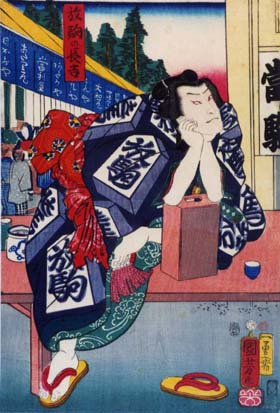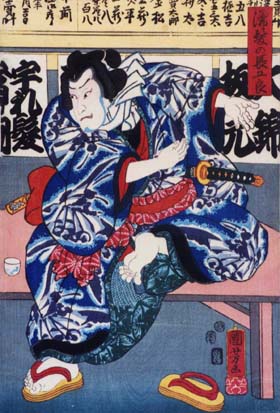| SUMďBA |
| Play titles | Futatsu Ch˘ch˘ Kuruwa Nikki A Diary of Two Butterflies in the Pleasure Quarters [1] |
| Common title | Sum˘ba |
| Authors | Takeda Izumo II Namiki Senryű I Miyoshi Sh˘raku |
| History |
The play in nine acts "Futatsu Ch˘ch˘ Kuruwa Nikki" was originally written for the puppets theater and performed for the first time in the 7th lunar month of 1749 at the Takemotoza in ďsaka. It was adapted for Kabuki a few weeks later by the zamoto Arashi San'emon IV in the 8th lunar month of 1749 in Ky˘to. The roles of the 2 sum˘ wrestlers Nuregami Ch˘gor˘ and Hanaregoma Ch˘kichi were played by the actors Nakayama Shinkur˘ I and Fujikawa Heikur˘. |
| Structure |
The "Horie Sum˘goya Mae" scene ("In front of the small sum˘ arena at Horie"), commonly called "Sum˘ba", is the second act of the play "Futatsu Ch˘ch˘ Kuruwa Nikki". |
| Key words |
Azuma-yojibŕmono Horie Gidayű Ky˘gen Sewamono Sum˘ Sum˘mono Sum˘tori |
| Summary |
The first scene takes place outside a sum˘ wrestling enclosure in Horie, where the last match of the day is going on between two wrestlers, Nuregami Ch˘gor˘, the favorite and certain winner, and the young upstart Hanaregoma Ch˘kichi. When the contest is over the spectators pour out, talking excitedly because Nuregami has lost. As the story unfolds we find out that the match was thrown. The truth is that Nuregami, a noted wrestler from ďsaka, wanted to help his merchant patron, Yamazaki Yogor˘, to whose father he was much indebted. Yogor˘ wanted to win the hand of his favorite geisha girl, Azuma, as his mistress. But Hanaregoma's samurai patron Hiraoka G˘zaemon also wanted to buy Azuma from the geisha house. So, hoping to help his merchant patron, Nuregami purposely lost the match so that Hanaregoma would get a promotion and would then owe Nuregami a favor. That favor was that Hanaregoma would try to dissuade his samurai patron from taking Azuma from the geisha house, so that Nuregami's patron could have her. The two wrestlers meet in front of the sum˘ enclosure. The young bluffing Hanaregoma gets angry when he hears the truth, as he had been elated over his victory, believing he had won by his own power. Nuregami tries to placate him, but Hanaregoma shows no sign of reconciliation. This summary has been written by Watanabe Hisao and edited by Jeff Blair [website] |
| Comments |
This short scene is usually performed independently of the rest of the play. When the play is performed as a T˘shi Ky˘gen, the "Sum˘ba" act is much longer and includes discussions between the characters about the events that occurred in the first act of the play, a comical scene in which Yogor˘ gives all his money and belongings to the people around him when they say they support Ch˘gor˘ and the triumphant walk of Ch˘kichi on the hanamichi. This scene is a typical Kamigata confrontation between 2 honest, proud characters with a high sense of honor, serving 2 opposite sides. It is usually followed by a reconciliation scene, where the character on the villains side joins the right side. In the case of "Futatsu Ch˘ch˘ Kuruwa Nikki", the reconciliation occurs in a following act ("Komeya"). |
| Notes |
[1] The title "A Diary of Two Butterflies in the Pleasure Quarters" comes from the 1st volume of "Kabuki Plays On Stage". |
 |
 |
|
The actors Nakamura Fukusuke I and Arashi Kichisabur˘ III playing the roles of Hanaregoma Ch˘kichi and Nuregami Ch˘gor˘ in the "Sum˘ba" act of the drama "Futatsu Ch˘ch˘ Kuruwa Nikki", which was staged in the 7th lunar month of 1854 at the Ichimuraza (print made by Utagawa Kuniyoshi) |
|
|
|
| Contact | Main | Top | Updates | Actors | Plays | Playwrights | Programs | Links | FAQ | Glossary | Chronology | Illustrations | Prints | Characters | Derivatives | Theaters | Coming soon | News |